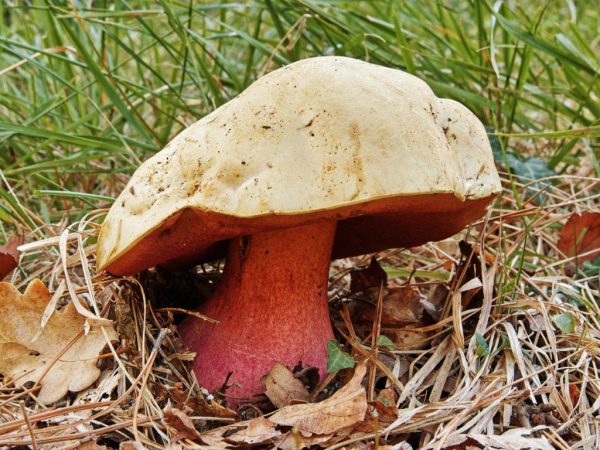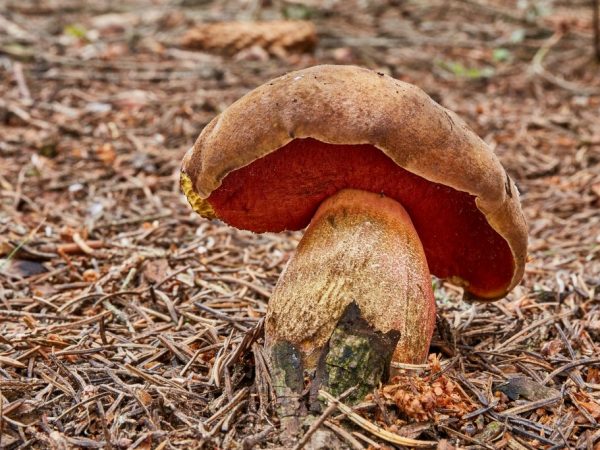Oak mushroom
The oak mushroom is a conditionally edible representative of a thermophilic species, which in the territory of the Russian Federation is found only in the Leningrad region, the Caucasus, the Far East and Siberia.

Oak mushroom
The appearance of the mushroom
The description of the 3 species of oak mushroom is generally similar, with the exception of some differences that are characteristic only of its varieties. Distinguish speckled oak, common and Kele.
Speckled oak
The speckled oak mushroom (Boletus erythropus) has a fleshy and usually large cap, the diameter of which is 5-20 cm. Its shape is hemispherical, cushion-shaped or rounded-cushion-shaped. The surface of the cap is matte and velvety, sometimes a little slimy, and with age it generally becomes bare. The color of the cap is chestnut brown, dark brown, dark brown, black-brown, red or olive. It is characteristic that when pressed on the area of the cap, it sometimes darkens to the point of blackening. The flesh of the cap is blue (or takes on a greenish-blue color) on the cut, usually yellow. The flesh of the leg is red or brown, has no aroma and taste. Spore powder of brownish-olive color.
Irina Selyutina (Biologist):
The speckled oak tree is very similar to the common oak tree, or d. Olive-brown, but there is no mesh pattern on its stem. Instead, small, carmine-red scales are present. The species is widespread in Europe, North Africa and Asia Minor. Its geographical area in the post-Soviet space is almost the same as that of the common oak tree and in the European part it reaches St. Petersburg, it is found in the Caucasus, the south of the Far East, and grows in isolation in Eastern Siberia.
This type of oak tree forms mycorrhiza with deciduous and coniferous representatives of tree species, because oak, spruce, fir and beech. Prefers acidic soils. It can be found in swampy areas among mosses.
This species is classified as conditionally edible mushrooms.
Common Dubovik
The common oak mushroom (bruise, oak, oak) - Boletus luridus - has the same diameter of a mature cap as that of a speckled one, which is hemispherical or convex in shape. The olive-brown integumentary tissue is velvety in structure; in damp weather it is covered with mucous secretions. It darkens from tactile influence (pressure). Occasionally there are mushrooms in which a rounded cap covers the leg like a cap to the head.
The pulp is also blue on the cut, fleshy inside, dense and yellow, at the base of the leg is red. There is no pronounced smell and taste. The surface of the leg is characterized by a convex reddish pattern with elongated "loops". The spore powder is olive-brown.
For normal life, it enters into a symbiotic relationship and forms mycorrhiza with beeches, oaks, and sometimes with birches. Prefers deciduous and mixed forests, where it is found in light, warm places.
Poddubnik is included in the category of conditionally edible mushrooms that need preliminary heat treatment due to the presence of toxins in the pulp that are not resistant to high temperatures. This type cannot be combined with alcohol. A raw or poorly cooked mushroom can cause gastrointestinal problems.
The bruise has a white poisonous double - a false satanic mushroom, which has a white cap with a gray tint. In general, it is similar to the underdubovik, and its pulp also turns blue when cut.
Dubovik Kele
According to the species description of the Kele oak mushroom (Boletus queletii), its cap is slightly smaller in diameter than that of the previous varieties, with a rounded convex shape. The peel is brown with a chestnut tint, velvety in young specimens; with age, it becomes dry, smooth and inseparable from the surface. The pulp is yellowish in color, fleshy consistency, much darker in the stem, bluish on the cut. The leg is cylindrical, somewhat thickened at the base, there is no mesh pattern on it. Spore powder of olive color.
Kele's oak tree is more toxic than speckled and it belongs to the group of inedible mushrooms, although there is information that it can be eaten, but with preliminary processing characteristic of conditionally edible species.
This species is found in deciduous forests.
Beneficial features
The subdubovik mushroom has a rich and varied chemical composition, which includes proteins, fats, carbohydrates, minerals, vitamins and other substances. The composition (per 100 g of product) includes:
- 92.5 g of water;
- 3.08 g protein;
- 0.36 g of fat (including 0.06 g of saturated fatty acids, 0.14 g of polyunsaturated fatty acids, 3 mg of campesterol);
- 3.28 g of carbohydrates (among which there are 1.45 g of glucose and 0.19 g of fructose);
- 0.9 g of inorganic substances.
The mineral composition per 100 g of fresh mushrooms mass is very rich and includes:
- 320 mg copper;
- 317 mg potassium;
- 84 mg phosphorus;
- 10 mg magnesium;
- 4 mg calcium;
- 4 mg sodium;
- 0.6 mg iron;
- 0.55 mg zinc;
- 0.046 mg manganese;
- 9.4 mcg of selenium.
The vitamin composition of common oak tree is no less rich, and which is presented per 100 g:
- 17.5 mg choline;
- 9.3 mg betaine;
- 3.609 mg niacin;
- 2.2 mg ascorbic acid;
- 1.495 mg of pantothenic acid;
- 0.404 mg riboflavin;
- 0.106 mg pyridoxine;
- 0.082 mg thiamine;
- 0.06 mg tocotrienol;
- 0.04 mg tocopherol;
- 18 mcg folate (folate)
- 2 μg dihydrophilloquinone;
- 0.5 μg calciferol;
- 0.04 μg cyanocobalamin; ...
The podunnik mushroom contains many amino acids necessary for the body:
- 0.033 g tryptophan
- 0.105 g threonine
- 0.078 g isoleucine
- 0.13 g leucine
- 0.104 g lysine
- 0.034 g methionine
- 0.014 g cystine
- 0.087 g phenylalanine
- 0.042 g tyrosine
- 0.235 g valine
- 0.074 g arginine
- 0.055 g histidine
- 0.198 g alanine
- 0.198 g aspartic acid
- 0.345 g glutamic acid
- 0.093 g glycine
- 0.072 g proline
- 0.096 g serine.

The mushroom contains many useful substances
Such a rich chemical composition determines the benefits of poddubnik:
- Kills bacteria with the antibiotic pain reliever present, fights nausea, dizziness and general weakness.
- It optimizes cardiac activity, since it significantly strengthens the muscles of the myocardium, evens out the rhythm, and reduces the risk of angina pectoris, ischemia and other diseases. Poddubovik is useful for hypertension, since it contains potassium and magnesium.
- It removes toxic compounds from the body by neutralizing the negative effects of radionuclides, heavy metal salts, and pathogenic bacteria. In addition, the substances of poddubovik reduce the level of cholesterol in the blood, thereby significantly reducing the risk of atherosclerosis, stroke, thrombophlebitis and heart attack.
- Stimulates the immune system, improving the condition of the epidermis derivatives: hair, nail plates, etc.
- It inhibits the aging process of the body due to the content of antioxidants that affect cell renewal and reduce the risk of all sorts of neoplasms.
- Optimizes the functioning of the central nervous system, preventing the emergence and development of neuroses.
- Stimulates the tightening of wounds, and also significantly facilitates the course of dermatological diseases, improves the condition of the skin in general.
- Increases potency, improves libido, sperm quality and male sexual activity, and also prevents prostate diseases.
- Helps the body effectively fight toxins, heavy metal salts and other unsafe compounds that enter the body from the environment.
- Copper, which is part of the mushroom, stimulates the thyroid gland.
Contraindications
Poddubovik is considered a conditionally edible mushroom due to the presence of toxic substances in its chemical composition. For this reason, it should not be consumed raw. To eliminate toxic substances, mushrooms are subject to heat treatment for 2 hours. If it has not been carried out, there is a risk of severe poisoning.
There are a number of contraindications to the use of oak speckled mushroom:
- Disruption of the digestive system - stomach and intestines.
- Ulcers of the stomach and duodenum, because essential oils and fiber contained in oak wood irritate mucous organs.
- Kidney pathologies such as prolapse or inflammation, stones. The course of these diseases is aggravated by a significant amount of water in the composition of poddubovik.
- Joint use with alcohol, which can increase the intoxication of the body.
- Eating in the morning or at night provokes a feeling of heaviness.
- Children under 14 years old. Adults tolerate the entry of fungal chitin into the body easily, while in children enzymes that can affect this substance are not yet produced due to the immaturity of the digestive system. Eating mushrooms can cause digestive upset or even intoxication.
Application
Podduboviki mushrooms have found their application both in medicine and in cooking.
In cooking
Dubovik is an edible tasty product. It is often pickled.
Recipe # 1: Pickled Oak Wood
- Add 2 tablespoons to 200 ml of boiled water. citric acid, 60 g sugar, 1 tsp. sea salt and 3 cloves of garlic.
- Add 2 liters of boiling water, 2 tablespoons. 9% table vinegar and 1 tbsp. honey.
- Then boil 1.5 kg of mushrooms and strain in a colander.
- Sterilize a large jar and put the previously prepared mixture on its bottom, and cooked oak woods on top.
- The resulting dish is left for 5 days.
Recipe # 2: Stuffed cabbage rolls
Boil the head of white cabbage for 3 minutes, separate the leaves and remove the lower dense parts. To prepare the filling, you need to rinse and clean 800 g of mushrooms, wrap them in cabbage leaves with the addition of 150 g of rice, add salt and pepper to taste. Then the carrots, onion and 2 tomatoes are fried. At the final stage, stuffed cabbage rolls and frying are added to the pan. All this is stewed for up to half an hour on low heat.
Recipe # 3: Soup with poddubniki
First, carrots and onions can be fried in vegetable oil. The mushrooms are washed, peeled and chopped, brought to a boil in a saucepan and then boiled for another 20 minutes, after which the water is drained. The mushrooms are boiled again, then the spices are added, and the boil lasts another half hour. After that, put in finely chopped potatoes and fry, salt. This dish is served on the table with sour cream and herbs.
Recipe number 4: Duboviks with potatoes
Boil the prepared oak woods for 15 minutes and discard in a colander. Cut the onion and potatoes into cubes, and the boiled mushrooms into large pieces. In a frying pan in vegetable oil, fry the onions and podiniks, add salt and a pinch of caraway to them. This whole mixture is stewed for up to 15 minutes. Potatoes are fried in the same way.
In medicine
The mushroom is useful in medicine because it contains restorative trace elements. The antibiotic Boletol was isolated from it, which suppresses many types of pathogenic bacteria. It is also effective to use this mushroom as an inhibitor of malignant neoplasms.
Conclusion
Podunnik mushroom is an invaluable source of useful compounds, a product for culinary specialists and a remedy in various fields of medicine.However, it is better to use this mushroom only after consulting a doctor.



